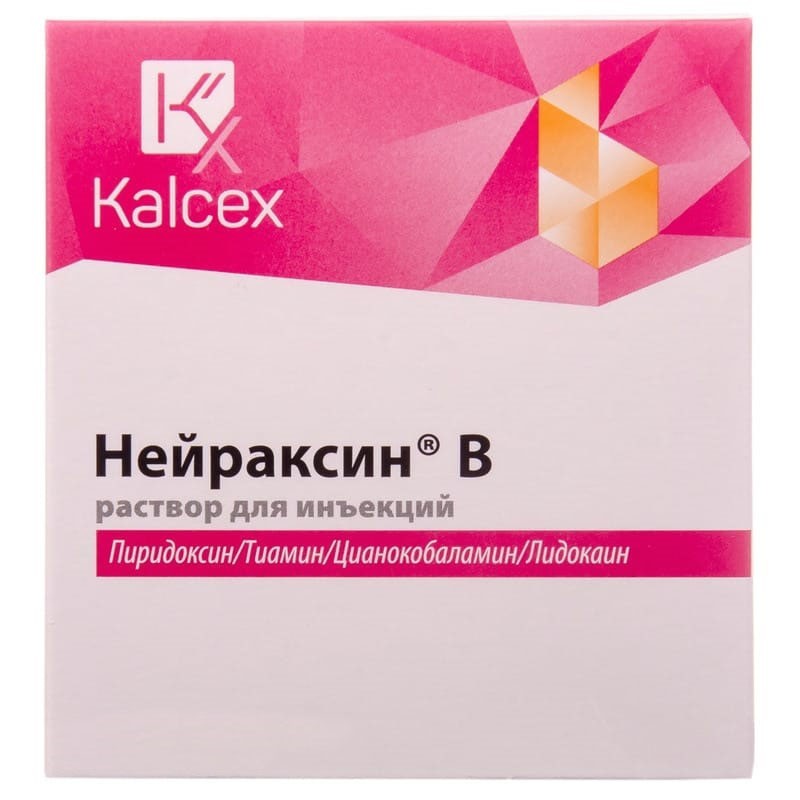



 Secure and encrypted payment processing
Secure and encrypted payment processing We ship to over 40 countries including the USA, UK, Europe, Australia and Japan
We ship to over 40 countries including the USA, UK, Europe, Australia and Japan Guaranteed refund or reship if you haven't received your order
Guaranteed refund or reship if you haven't received your orderSolution for injections "Neuraxin® B ”is used for neurological diseases of various origins: neuritis, neuralgia, polyneuropathy (diabetic, alcoholic), radicular syndrome, retrobulbar neuritis, facial nerve damage.
2 ml of solution (one ampoule) contains (active substances):
Excipients: benzyl alcohol, sodium tripolyphosphate, sodium hydroxide, potassium hexacyanoferrate (III), water for injection.
For intramuscular use.
Injection solution is injected deep into muscle tissue to avoid cardiovascular adverse reactions.
For severe and acute symptoms: one injection (2 ml) is administered 1 time per day to achieve a high level of active substances in the blood. When the acute phase subsided and with less severe symptoms, prescribe one injection 2-3 times a week.
Elderly patients: dose adjustment is not required.
How to open an ampoule:
A safe daily dose of vitamin B6 during pregnancy or breastfeeding is up to 25 mg. The drug contains 100 mg of vitamin B6 in an ampoule, so it should not be used during pregnancy or breastfeeding.
"Neuraxin® B ”does not affect the ability to drive vehicles or work with complex mechanisms. If dizziness is observed during treatment, one should refrain from driving vehicles or working with mechanisms.
Vitamin B1 has a wide therapeutic range. Very high doses (more than 10 g) exhibit a curariform effect, suppressing the conduction of nerve impulses.
Vitamin B6 has a very low toxicity.
Excessive use of vitamin B6 at a dose of more than one g per day for several months can lead to neurotoxic effects.
Neuropathies with ataxia and sensitivity disorders, cerebral seizures with changes in the electroencephalogram (EEG), as well as in some cases hypochromic anemia and seborrheic dermatitis have been described after the introduction of more than 2 g per day.
Vitamin B12: after parenteral administration (in rare cases, after oral administration), doses of the drug are higher than recommended, allergic reactions, eczematous skin disorders and benign form of acne were observed.
With prolonged use in high doses, a violation of the activity of liver enzymes, pain in the heart, and hypercoagulation are possible. Treatment: symptomatic therapy.
Lidocaine. Symptoms: psychomotor agitation, dizziness, general weakness, decreased blood pressure, tremor, visual impairment, tonic-clonic convulsions, coma, collapse, atrioventicular block, central nervous system depression, respiratory arrest are possible. The first symptoms of an overdose in healthy people occur when the concentration of lidocaine in the blood is more than 0.006 mg / kg, convulsions - at 0.01 mg / kg.
Treatment: cessation of drug administration, oxygen therapy, anticonvulsants, vasoconstrictors (norepinephrine, mesatone), with bradycardia - anticholinergics (0.5-1 mg of atropine). Perhaps intubation, mechanical ventilation, resuscitation. Dialysis is not effective.
Long-term use (more than 6-12 months) in doses of more than 50 mg of vitamin B6 daily can lead to peripheral sensory neuropathy, nervous agitation, malaise, dizziness, headache.
From the digestive tract: gastrointestinal disorders, including nausea, vomiting, diarrhea, abdominal pain, increased acidity of gastric juice.
On the part of the immune system: hypersensitivity reactions (skin rash, respiratory failure, anaphylactic shock, Quincke edema), excessive sweating.
On the part of the skin: itching, urticaria, acne; extremely rarely - generalized exfoliative dermatitis, angioedema.
From the side of the cardiovascular system: tachycardia, arrhythmia, bradycardia, cardiac conduction deceleration, transverse heart block, cardiac arrest, peripheral vasodilation, collapse; very rarely - tachycardia, increase / decrease in blood pressure, heart pain.
From the nervous system: excitation of the central nervous system (CNS) (when used in high doses), anxiety, headache, dizziness, sleep disturbance, confusion, drowsiness, loss of consciousness, coma; in patients with hypersensitivity - euphoria, tremor, trismus, motor anxiety, paresthesia, convulsions.
On the part of the organs of vision: nystagmus, reverse blindness, diplopia, flickering of “flies” before the eyes, photophobia, conjunctivitis.
On the part of the hearing organs: auditory disorders, tinnitus, hyperacusis.
From the respiratory system: shortness of breath, rhinitis, oppression or respiratory arrest.
Others: sensation of heat, cold or numbness of the extremities, swelling, weakness, malignant hyperthermia, sensitivity disorders, motor block.
General disorders: reactions at the injection site.
In the case of very rapid parenteral administration, the development of systemic reactions in the form of seizures is possible.
Pyridoxine is incompatible with drugs containing levodopa, since with simultaneous use, peripheral decarboxylation of the latter is enhanced and, thus, its antiparkinsonian effect is reduced.
Thiamine is incompatible with oxidizing agents and reducing agents, mercury chloride, iodine, carbonate, acetate, iron sulfate, tannic acid, ammonium citrate, phenobarbital, riboflavin, benzylpenicillin, glucose and metabisulfite. Copper accelerates the breakdown of thiamine; in addition, thiamine loses its effect at elevated pH levels (> pH 3).
Vitamin B12 is incompatible with oxidizing agents and reducing agents, as well as with salts of heavy metals. In solutions containing thiamine, vitamin B12, as well as other B-complex factors, are destroyed by thiamine degradation products (a low concentration of ferric ions can prevent this). Also, riboflavin (especially with the concomitant effect of light) has a degrading effect. Nicotinamide accelerates phytolysis, while antioxidants have an inhibitory effect.
Store in a refrigerator at a temperature of 2 ° C to 8 ° C. Do not freeze. Store in the original packaging to protect from light.
Shelf life is 2 years.